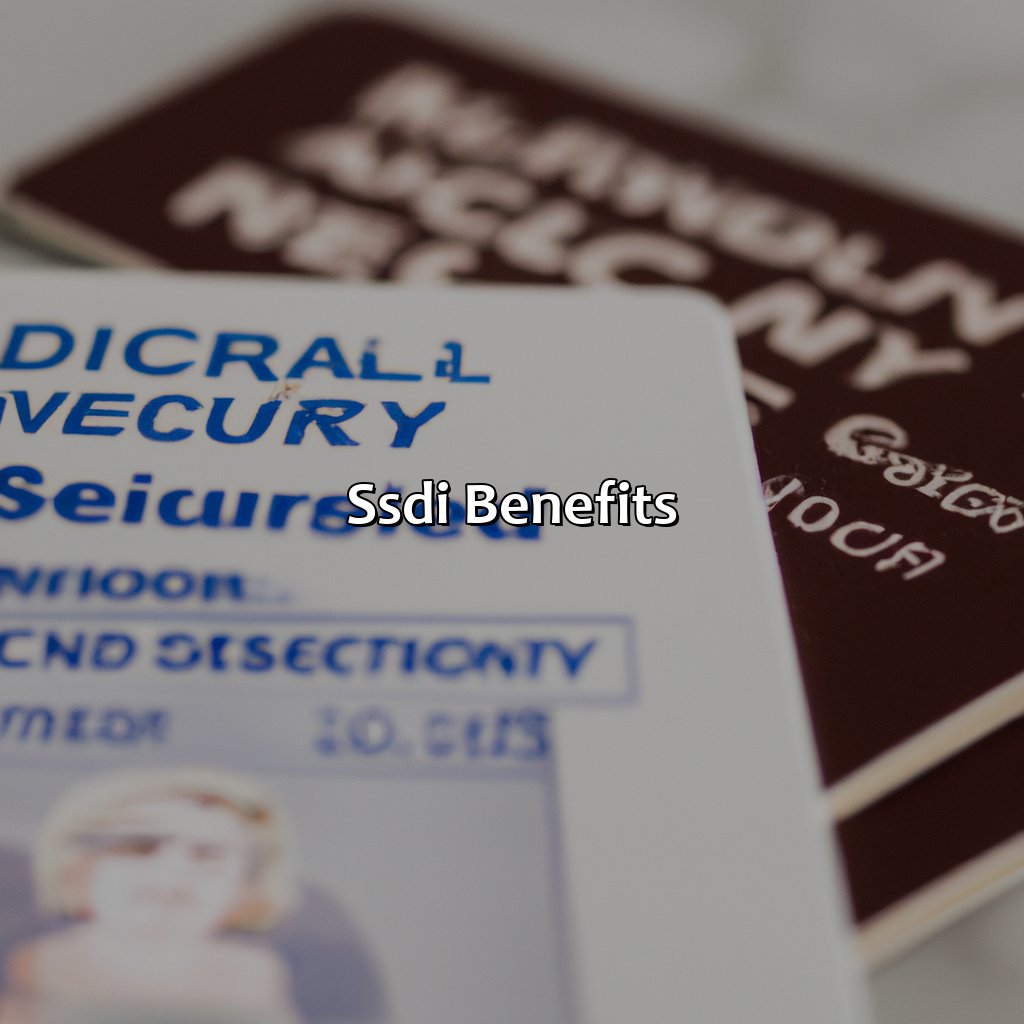When Does Ssdi Become Social Security?
Key Takeaway:
- SSDI benefits are available to individuals with disabilities who have worked and paid Social Security taxes. To be eligible, you must have a medical condition that is expected to last at least 12 months or result in death, and that prevents you from working.
- To apply for SSDI benefits, you can do so either online, by phone, or in person at a Social Security office. You will need to provide documentation of your disability, work history, and income.
- The amount of SSDI benefits you receive depends on your average lifetime earnings before your disability began. Benefits are adjusted for inflation and may be reduced based on other forms of income you receive.
- Social Security retirement benefits are available to individuals who have reached full retirement age, which is currently 66 years and 2 months for those born in 1955. You may apply as early as age 62, but your benefits will be reduced. You may also delay receiving benefits until age 70 and receive an increased monthly amount.
- To apply for Social Security retirement benefits, you can do so either online, by phone, or in person at a Social Security office. You will need to provide documentation of your age, work history, and income.
- SSDI benefits can become Social Security retirement benefits when the recipient reaches full retirement age. There is no additional application or transition process required.
Are you trying to understand how Social Security Disability Insurance (SSDI) can become a part of Social Security Retirement benefits? Here, you’ll learn the requirements of making the transition and receive answers to other crucial questions.
SSDI benefits
To get the low-down on SSDI benefits – eligibility, how to apply and the amount of benefits you can receive – you need to get clued-up. It all depends on your work history and medical conditions. Applying requires medical and work history documents. The benefits you can expect vary depending on your earnings and if you’re married.

Image credits: retiregenz.com by Harry Duncun
Eligibility
The criteria for qualifying for Social Security Disability Insurance (SSDI) are stringent. Applicants must have worked a certain number of years, earned enough income, and have a medical condition preventing them from working. The Social Security Administration (SSA) thoroughly evaluates applications and provides benefits to those who meet the requirements.
To be eligible for SSDI, applicants must be under the age of retirement and unable to work due to a medical condition that has lasted or is expected to last at least 12 months or result in death. Additionally, they must have worked and paid Social Security taxes for a certain number of years depending on their age at the onset of their disability.
Furthermore, applicants must meet the SSA’s definition of disability, which means that they cannot perform substantial gainful activity due to their medical condition. The SSA considers various factors such as age, education level, work experience, and transferable skills when evaluating an applicant’s ability to work.
It is worth noting that SSDI becomes regular Social Security retirement benefits once the recipient reaches full retirement age. This transition happens automatically, but recipients can choose to remain on SSDI if they prefer.
According to research conducted by the Center on Budget and Policy Priorities, nearly 10 million people receive SSDI benefits in America as of December 2020.
Getting SSDI benefits is easier than getting a date, but at least with SSDI you don’t have to worry about rejection letters.
How to apply
To start your application for SSDI benefits, you must follow a specific process. The first step of the application process involves completing an online application or calling the Social Security Administration to request an appointment.
Here is a five-step guide to help you with how to start your SSDI benefits application:
- Gather all necessary information and documentation, including Social Security numbers, birth certificates, medical records, and employment history.
- Fill out the online application or schedule an appointment with the SSA by phone or in person.
- Submit your completed applications and any necessary documentation to the SSA.
- The SSA will review your application and may contact you for additional information or to schedule a medical exam.
- Upon approval, you will begin receiving monthly benefits via direct deposit.
It is essential to note that even if your initial claim is denied, there may be options for appeal through reconsideration and hearing.
It’s worth mentioning that applying for SSDI benefits can be a lengthy process that requires patience. It is crucial to provide adequate documentation and information about your disability. Additionally, you should apply as soon as possible after deciding that you cannot work due to your disabling medical condition.
One individual’s true-life account highlights the importance of submitting thorough documentation early on in the process. Despite significant trauma resulting from a car accident that prevented him from working, he assumed his health would improve promptly. His claims were initially denied because he did not provide sufficient detail regarding his injuries’ severe nature. However, with supporting evidence later produced during his appeal hearing, he was approved for benefits – affirming the value of providing complete documentation upfront.
Your bank account won’t be singing “Ain’t No Mountain High Enough” once you see the modest SSDI benefit amount.
Amount of benefits
The financial benefits offered by Social Security Disability Insurance (SSDI) can be a lifeline for individuals with disabilities. These benefits are calculated based on the recipient’s average lifetime earnings before any disability, and the amount of benefits depends on various factors.
- One of the factors determining SSDI benefits is the disabled individual’s earnings before their disability. The higher the income, the higher the benefits.
- Another factor affecting the amount of benefits is how much an individual has paid into Social Security taxes. More payments lead to more substantial benefit payouts.
- The third significant factor that influences SSDI benefits is whether or not other family members rely on the recipient’s Social Security record to get their own benefits paid. In this case, your spouse and minor children can also receive payouts based on your earnings history, further increasing your total benefits.
- In addition to these factors, inflation rates, cost-of-living adjustments and fluctuating tax rules are some other variables that come into play while calculating SSDI payouts.
- Last but not least, retroactive pay may increase new applicants’ first payment as it includes potential unclaimed payments from previous years dating back to their initial eligibility date.
It’s important to note that besides Social Security Disability Insurance (SSDI), there are separate programs for those with limited income and resources such as Supplemental Security Income (SSI). It is essential to work with an expert who can help identify which program best suits your needs.
Needless to say, these financial benefits have been instrumental in helping people deal with various medical issues that limit their ability to work and earn money. Take for instance John who suffered from muscular dystrophy and was unable to continue working despite trying his best for multiple years. He turned towards SSDI assistance and received reliable financial support after struggling for a long time. Such stories highlight how valuable social security benefits can be for those facing difficult times.
Retirement is just a fancy word for prioritizing bingo nights over bar crawls, but at least Social Security has got your back.
Social Security retirement benefits
Gaining knowledge on Social Security retirement benefits? Eligibility, application process and benefit amounts can all be quickly uncovered!

Image credits: retiregenz.com by Joel Duncun
Eligibility
To qualify for Social Security retirement benefits, certain eligibility criteria should be met. This includes having enough credits earned through work, reaching full retirement age or being eligible for early benefits, and being a US citizen or lawful permanent resident.
Additionally, if you have received Social Security Disability Insurance (SSDI) prior to reaching full retirement age, your benefits will automatically convert to retirement benefits. However, the amount of your benefit may change depending on when you start receiving it.
It’s important to note that if you continue to work while receiving Social Security benefits before reaching full retirement age, your benefits may be reduced temporarily.
To ensure the maximum benefit amount in retirement, it is advised to wait until full retirement age or even later before claiming Social Security benefits. Additionally, working longer and increasing earned income can also increase the benefit amount.
Ready to start your retirement party? Here’s how to apply for those sweet Social Security benefits:
How to apply
When to initiate the social security retirement benefits application process? It should be done at least three months before you turn 65 or opt-out of any disability benefits. Here is a step-by-step guide on how to apply for social security retirement benefits using the online platform:
- Set up an account on the official Social Security website
- Fill out the online application form with details regarding income, taxes, and employment history.
- Upload supporting documents such as birth certificate, tax returns, and bank statements if needed.
- Submit your application and wait for confirmation from Social Security Administration (SSA).
- If needed, participate in follow-up interviews and respond promptly to requests from SSA.
Social Security offers many other types of benefits including disability insurance. These are separate from social security retirement benefits.
A true fact: According to the Social Security Administration Annual Statistical Supplement, over 48 million people were receiving social security retirement benefits as of December 2020.
Social security retirement benefits – the one thing that provides a steady income in your golden years without having to resort to robbing a bank.
Amount of benefits
Social Security retirement benefits – Understanding the Amount of Benefits
Retirement benefits that you receive from Social Security can provide financial security, but it’s essential to understand the amount of benefits you’ll be receiving.
- Calculations are based on your highest 35 years of earnings. Therefore, the more you earn, the higher your benefit will be.
- The age in which you retire also affects your benefit amount. If you choose to start collecting at full retirement age (between 66-67), you’ll receive your full calculated amount. But if you opt to start at a younger age, there will be a reduction in the monthly payment. On the other hand, if you wait until after full retirement age, you may increase your monthly payout up until age 70.
- For certain situations like having dependent children or being a widow(er), family members may also receive benefits from your retirement earnings record.
It’s significant to note that Social Security is adjusted periodically for cost-of-living changes and given updates to their formula for calculating benefits. Every year, recipients are updated with a COLA (cost-of-living adjustment) increase with an objective of keeping their purchasing power consistent over time.
Knowing about these factors is vital when making decisions about when to start accepting Social Security retirement benefits.
Here’s a story that highlights this-
John retired early and started taking social security payouts at the age of 62. Though his payments helped him in meeting current needs but he realized quickly that he could have gotten much more had he waited until full retirement age as his work had paid him decently compared to others. Over time he saw how those who did waited out were getting significantly higher payouts thus limiting his options for holidays and indulgences later on in life – something which could have been possible if only he was aware ahead of time.
When it comes to SSDI becoming Social Security, the only thing more confusing than the acronym itself is trying to navigate the government’s website.
When SSDI becomes Social Security
To comprehend when SSDI converts to Social Security, this segment will uncover the age requirement. The age requirement decides when SSDI changes to retirement benefits. Additionally, the transition process outlines how this switch occurs.

Image credits: retiregenz.com by David Woodhock
Age requirement
When Can You Qualify for Social Security Disability Insurance Benefits?
If you have a medically-documented condition that limits your ability to work, and you cannot earn more than a certain amount of money each month, you may qualify for SSDI benefits. To be eligible for SSDI, the Social Security Administration requires that you have worked long enough and recently enough to have earned sufficient credits. The age requirement states that you must be under full retirement age (currently 66) at the time that you became disabled.
It is essential to note that SSDI is not related to your income or resources currently; instead, it is dependent on your previous working status and earnings record. This enables individuals who previously held high-paying jobs but can no longer perform them due to their disability to continue receiving benefits as they seek new avenues of work.
According to the National Institute on Aging, some conditions make it easier for people over 50 years of age to acquire SSDI more easily than younger applicants experiencing similar problems. For instance, over half of all awarded disability claims are offered to seniors or individuals aged over 50.
A recent report by The New York Times stated that about one in eight people receive SSDI payments in America, placing significant pressure on government programs’ sustainability and budgets in the future.
Switching from SSDI to Social Security is like going from being a caterpillar to a butterfly, except the butterfly has to fill out endless paperwork.
Transition process
The process of transitioning from SSDI to Social Security can be complex. Once a recipient reaches full retirement age, their SSDI benefits automatically convert to Social Security retirement benefits. However, if the recipient is under full retirement age and their disability improves or they return to work, they may undergo a review to determine if they still qualify for disability benefits.
During this review, the Social Security Administration will assess the recipient’s medical conditions and ability to work. If it is determined that the recipient no longer meets the criteria for disability, their SSDI benefits will cease and they will be transitioned to Social Security retirement benefits based on their age at that time.
It’s important for recipients to stay informed about their benefits and any changes in their eligibility. They should also keep accurate records of any medical treatment or disability-related expenses. Seeking legal or financial advice can also be beneficial in navigating this process smoothly and ensuring maximum benefits.
5 Well-Known Facts About When SSDI Becomes Social Security:
- ✅ SSDI (Social Security Disability Insurance) turns into Social Security retirement benefits when the recipient reaches full retirement age. (Source: Social Security Administration)
- ✅ Full retirement age is determined based on the recipient’s birth year and ranges from 66 to 67 years old. (Source: AARP)
- ✅ SSDI recipients automatically switch over to Social Security retirement benefits when they reach full retirement age. (Source: SSA)
- ✅ The amount of Social Security retirement benefits a recipient receives is based on their work history and the age they start receiving benefits. (Source: SSA)
- ✅ If an SSDI recipient starts receiving Social Security retirement benefits before reaching full retirement age, their benefit amount will be reduced. (Source: SSA)
FAQs about When Does Ssdi Become Social Security?
When Does SSDI Become Social Security?
SSDI becomes Social Security at your full retirement age.
Do I Receive the Same Benefits on SSDI as on Social Security?
Yes, the benefit amount is the same for SSDI and Social Security retirement benefits.
Can I Collect Both SSDI and Social Security Retirement Benefits?
Yes, if you are eligible for both, you can receive both SSDI and Social Security retirement benefits.
When Should I Apply for Social Security Retirement Benefits if I Have Been Receiving SSDI?
You will automatically be enrolled in Social Security retirement benefits when you reach full retirement age. However, you may want to apply earlier if you are eligible for additional benefits or want to start receiving benefits sooner.
What Happens to My SSDI Benefits When I Reach Full Retirement Age?
Your SSDI benefits will automatically convert to Social Security retirement benefits at your full retirement age.
What if I Have a Disability and Reach Full Retirement Age?
If you have a disability and reach full retirement age, you will continue to receive your SSDI benefits, but they will be converted to Social Security retirement benefits.


